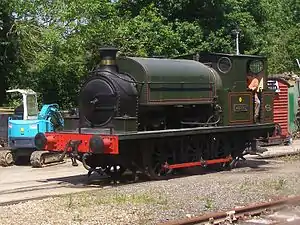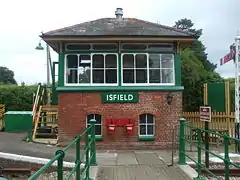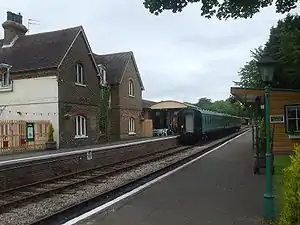Lavender Line
The Lavender Line is a heritage railway based at Isfield Station, near Uckfield in East Sussex, England.
| Lavender Line | |
|---|---|
 Kitson 0-6-0ST "Austin I" built in 1932 | |
| Locale | near Uckfield in East Sussex |
| Commercial operations | |
| Original gauge | 4 ft 8 1⁄2 in (1,435 mm) standard gauge |
| Preserved operations | |
| Owned by | Lavender Line Preservation Society |
| Stations | 2 |
| Length | 1 mi (1.6 km) |
| Preserved gauge | 4 ft 8 1⁄2 in (1,435 mm) standard gauge |
| Commercial history | |
| Opened | 1858 |
| Closed | 1969 |
| Preservation history | |
| Headquarters | Isfield Station |
History
The Lavender Line formed part of the Lewes to Uckfield Railway when it was opened on 18 October 1858. Within 12 months of its opening, the branch had been integrated into the London, Brighton and South Coast Railway (LB&SCR) to safeguard the company’s interests east of its London to Brighton main line. Ten years from its opening, Isfield saw through workings from Brighton to Tunbridge Wells and Tonbridge, via a new Uckfield–Groombridge link. This scheme necessitated track diversion work north of Lewes, to obviate trains having to reverse, and the branch therefore assumed a new course, entering Lewes from the North.
Prior to that time trains from Uckfield travelling south to Lewes joined the Keymer Junction to Lewes line at Hamsey, latterly called the "Hamsey Loop." A new scheme required major track diversion work north of Lewes, in order to remove the need for trains having to reverse at Lewes. So the line took a new course, with the abandoning of the Hamsey Loop and assumed a new course, entering Lewes from the North, traversing a bridge over the River Ouse then a bridge over Cliffe High Street to Lewes Station via a number of embankments. Such a route was indeed heavily engineered. As a result of this the mileage of the line also changed following this route alteration, and with the nought milepost now at Brighton, Isfield’s location now became 13.6 miles (21.9 km).
Bluebell Line
What was the East Grinstead branch originally branched off the line just south of what is now the Lavender Line at Culver Junction, near Culver Farm between Lewes and Barcombe Mills. Part of the East Grinstead branch now makes up the Bluebell Railway. The junction closed in 1958 with the closure of the East Grinstead to Lewes line.
Closure
As early as 1964 BR was aware of planned road works in and around the Lewes area, in which a bypass (Phases 1, 2 & 3) around Lewes was planned; as part of this the building of the Phoenix Causeway (Phase 1) would mean that a section of the Lewes to Uckfield railway line was in the way – requiring either a level crossing or a road bridge. BR therefore applied for an Act of Parliament to reinstate the Hamsey loop. Curiously in 1966 the local TUCC received notification from BR that the line from Lewes to Hurst Green Junction was to close in its entirety. The reason for this was that the line was one of those slated for closure in the first Beeching report published in 1963, listing it as an unremunerative line.
Opposition from the many railway travellers resulted. Their case was centred on the fact that a motorway costing formula was used to prove that the users would waste some £750,000 in excess travel compared to BR's calculated loss of only £260,000. In the end the TUCC upheld the users' complaints. In early 1968 BR made another attempt to close the line. This time the Transport Minister, Barbara Castle, requested more information from BR, which was furnished to her successor, Richard Marsh, who took over as Transport Minister in April 1968. At this time structural problems with the bridge over Cliffe High Street in Lewes were identified, which necessitated single line working, with a revised timetable in place to reflect this.
From the information requested by his predecessor, and of all the scenarios that were examined by the Minister, he agreed in August 1968 to the closure of the Lewes to Uckfield section of line. But the resultant row over the severing of what was a very important rail link began. Considerable opposition from the users centred, in the first instance, around the inadequate replacement bus service – which had Ministerial approval. The issue was resolved by the Transport Commissioners who, on examination of all the complaints from the users and undertaking the journey themselves, upheld the users' complaints. However concerns over the state of the bridge over Cliffe High Street remained and finally the BR Chief Civil Engineer declared the bridge unsafe. This meant the cessation of rail services along this section of line, with a replacement bus service in place. All of these actions resulted in the delaying of the closure from January 1969 to May 1969.
In late 1968, BR made application to close the remaining section of the line, from Uckfield to Hurst Green Junction. This was refused in January 1969 by the Minister as the line was of a social need, and in accordance with Section 39 of the Transport Act 1968 as subsidy could be paid with Treasury approval for a three-year period.
The subsequent sale of the track bed was postponed following the prospect of a number of schemes to re-open the closed section of the line. But they were all unsuccessful, and it is for this reason that it took 15 years for the railway to become available to private buyers. Even so, certain covenants have been inserted into the deeds stating that there is to be no building on this land and it can be compulsorily purchased back should the need arise to reinstate the line.
Restoration
On 16 June 1983 Isfield railway station was purchased at auction by Dave and Gwen Milham with restoration of the station in mind. The rebuilding began immediately, including the laying of new track, the renovation of the signal box, and renewal of the all yellow perimeter fence. The booking hall was renovated, the station awning renewed, and all platform signs replaced. The original platform waiting room had been purchased from Isfield by the Bluebell Railway in 1978, and resituated at Sheffield Park station. Two months were spent constructing an exact replica, completed in January 1984. In cooperation with the Bluebell Railway Dave Milham purchased track material from British Rail, made available from work being done at Croydon.
The station was named 'The Lavender Line' since A.E. Lavender and Sons were the local coal merchants who had operated from the station yard. Two engines were purchased for use at the station: 'Annie', a Barclay 0-4-0 saddle tank previously in service at Bury Transport Museum, and 'Ugly', RSH 0-6-0 saddle tank number 64, purchased while on loan at the North Yorkshire Moors Railway. A third engine was purchased, a 2-10-0 built by the North British Locomotive Company, which had to be shipped from Greece to the United Kingdom. The engine was christened 'Dame Vera Lynn' by Dame Vera Lynn herself at the station on 6 August 1986. This engine proved too large for the tracks, however, and was sold to Clifford Brown, a British-born American businessman living in Virginia, USA. Mr Brown sent the engine to the North Yorkshire Moors Railway where it now resides.
The main restoration that took place at the station was completed by the spring of 1987. This included the renovation of the station buildings, and the reinstatement of 1⁄4 mile (0.40 km) of permanent way on the original track bed, later extended by the preservation society to 1 mile (1.6 km). Any further extension was not considered feasible, due to a weak bridge crossing the River Uck, although this was cleared and prepared for inspection in 2012.[1] Additionally, a new 100 by 60 feet (30 m × 18 m) engine shed was constructed at Isfield. The total cost of restoration exceeded £750,000.
Stations
Isfield
Ownership of Isfield station passed from the Milham family to the preservation society in 1991. It remains the headquarters, operating base, and engineering base of the Lavender Line. Since its restoration in the 1980s the station has been a popular attraction for the local area, and remains a well-celebrated example of a restored period railway station. The station has won awards for its restoration, and proved popular as a location for film and television shoots requiring a period railway station.
Worth Halt
Work started in December 2011 on building a halt style platform at Little Horsted, together with a picnic area. It was opened on the Saturday of the first Diesel Gala in July 2012, and named Worth Halt. The construction of the halt allows passengers to travel between two permanent stations, whilst the line remains limited to its current one mile length.
Future expansion
Despite attempts by the Wealden Line Campaign to have the line from Uckfield through Isfield to Lewes reopened to passenger traffic, a July 2008 study concluded that although technically feasible, the line would be "economically unviable".[2] Any reopening might affect the operations of the Lavender Line or entail a move to a new location, however there is no definite statement on this point and in any event the campaign has not succeeded.
The Preservation Society expressed an interest in itself restoring and reopening the line between Uckfield and Lewes in the long-term future.[3] In December 2008, a petition was presented to East Sussex County Council asking it to acquire the trackbed from the Lavender Line's northern boundary to the former site of Uckfield station, to lease back the section and to allow heritage services to be run over it. In April 2009, the Council's Director of Transport and Environment recommended that the petition be refused on the basis that a heritage operation would prejudice the reopening of the line and the costs entailed would divert funding away from core Council services.[4]
Rolling Stock
Steam locomotives
| Name | Works No | Builder | Type | Year Built | Owner | Status | Notes |
|---|---|---|---|---|---|---|---|
| Lady Lisa | 2945 | Cockerill | 0-4-0VBT | 1920 | Privately Owned | Operational | Previously Yvonne |
Diesel locomotives
| Name | Number | Builder | Works No | Type | Year Built | Owner | Status |
|---|---|---|---|---|---|---|---|
| - | Army 221 | Andrew Barclay | 354 | 0-4-0DM | 1941 | Privately Owned | Operational |
| - | Army 830 | Vulcan / Drewry | VF 5257 / DC 2176 | 0-4-0DM | 1945 | Privately Owned | Under Restoration |
| Valiant | 422 | Ruston & Hornsby | - | 0-6-0DH | 1961 | Lavender Line Preservation Society | Operational |
| Planet | 15 | Hibberd | - | 4wDM | - | Lavender Line Preservation Society | Operational |
| - | 09 025 / D4113 | BR Horwich | - | 0-6-0DE | 1962 | Lavender Line Preservation Society | Operational |
Diesel-mechanical multiple units
| Class | Number | Builder | Built | Type | Owner | Status | Notes |
|---|---|---|---|---|---|---|---|
| 108 | 56279 | BR Derby | 1960 | DTCL | Lavender Line Preservation Society | Operational | Used as loco-hauled carriage. |
| Railbus | Laboratory 20 | Wickham | 1958 | Track Recording Car | Privately owned | Operational | Interior now equipped for passenger-carrying. |
Diesel-electric multiple units
| Unit No. | DMBSO | DTCsoL | Built | Owner | Status | Notes |
|---|---|---|---|---|---|---|
| 1118 | 60117 | 60828 | 1957 | Private | Operational | [5] |
| 1121 | - | 60820 | 1958 | Hastings Diesels Ltd. | Operational | DMBSO not preserved. |
| 1123 | 60122 | - | 1958 | Hastings & Sussex Units Preservation Society | Stored | Trailer vehicles at Swindon and Cricklade Railway.[6] |
| 1133 | 60151 | 60832 | 1962 | Lavender Line Preservation Society | Operational | DTCsoL under restoration. TSO originally preserved but later sold now a farmers hay barn. |
Electric multiple units
| Unit No. | DTCsoL | MBSO(T) | TSO | DTSOL | Owner | Status | Notes |
|---|---|---|---|---|---|---|---|
| 309616 | 75642 | 61937 | - | 75981 | Lavender Line Preservation Society | Under Restoration | TSO from unit not preserved |
Carriages
| Origin | Number | Type | Notes | Photograph |
|---|---|---|---|---|
| BR | 21273 | MK.I Brake Corridor Composite | Operational. | |
| BR | 69333 | Class 422 Buffet Car | Stored. | |
| BR | 81214 | MK.I Gangwayed Full Brake | Used as a store vehicle. |
Gallery
 WD Austerity 2-10-0 'Dame Vera Lynn' departing Isfield.
WD Austerity 2-10-0 'Dame Vera Lynn' departing Isfield. The end of the line at Little Horsted.
The end of the line at Little Horsted. Isfield signal box.
Isfield signal box. A general view of Isfield station.
A general view of Isfield station.
References
- Lavender Line (16 December 2011). "Lavender Line News December 16th". Retrieved 20 December 2011.
- East Sussex County Council (23 July 2008). "Issued on behalf of the Central Rail Corridor Board: Rail study report concludes that reinstatement is not economically viable" (Press release). Retrieved 21 August 2008.
- Wealden District Council (December 1998). "Local Plan; Chapter 9: Transport, paragraph 9.69" (PDF). Retrieved 24 December 2014.
- East Sussex County Council (7 April 2009). "Petition to extend, and designate, the Lavender Line as a heritage railway: Report by the Director of Transport and Environment" (PDF). Archived from the original (PDF) on 23 February 2012. Retrieved 23 July 2009.
- VCT (5 October 2016). "BR S60117 'Hampshire' Driving Motor Second built 1957". Retrieved 30 July 2016.
- "Replacement carriage arrives at Swindon and Cricklade Railway as arson investigation continues". 30 July 2016. Retrieved 30 July 2016.
External links
- Lavender Line website
- Wealden Line campaign website
- Review of railway on Qype